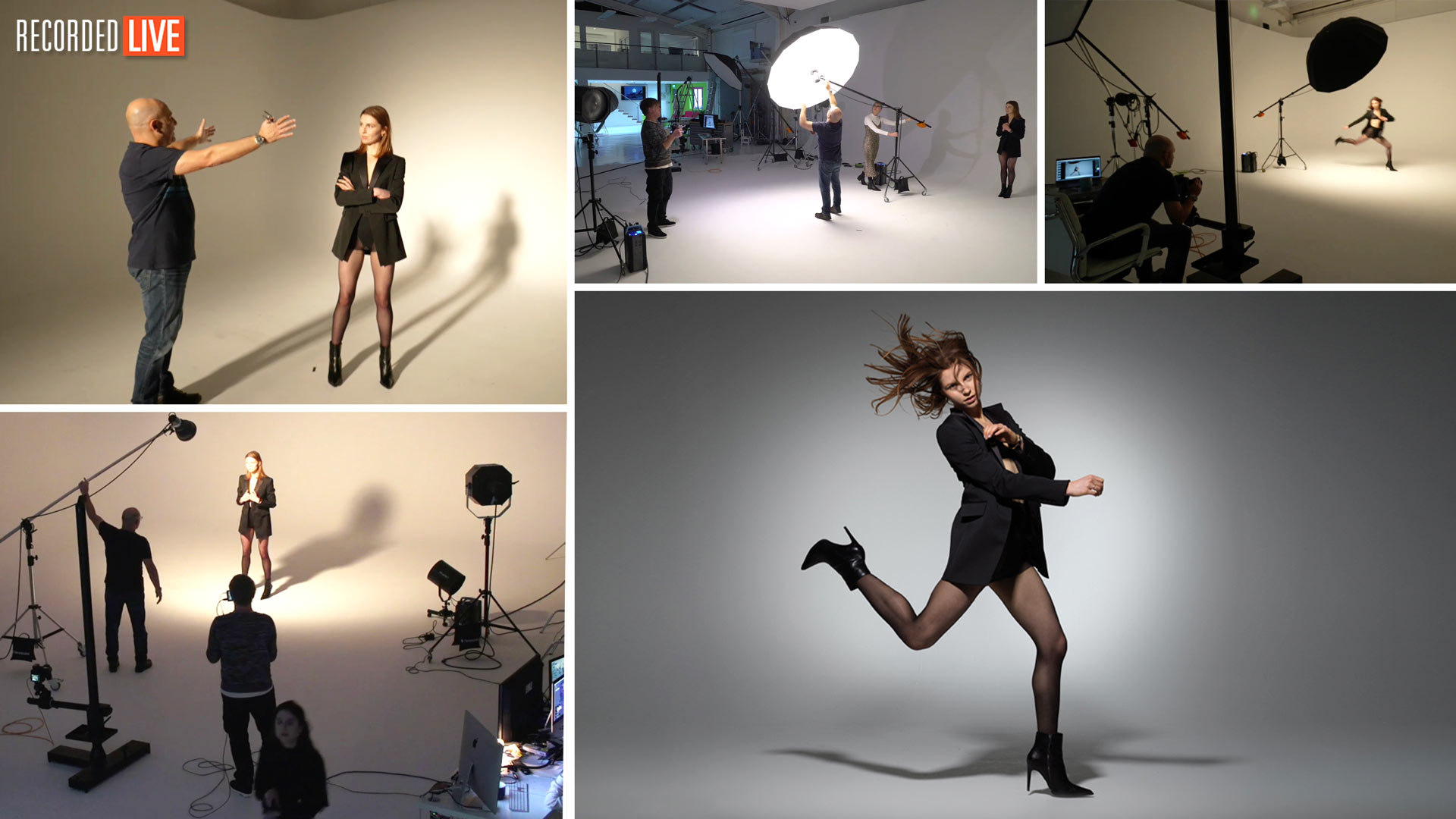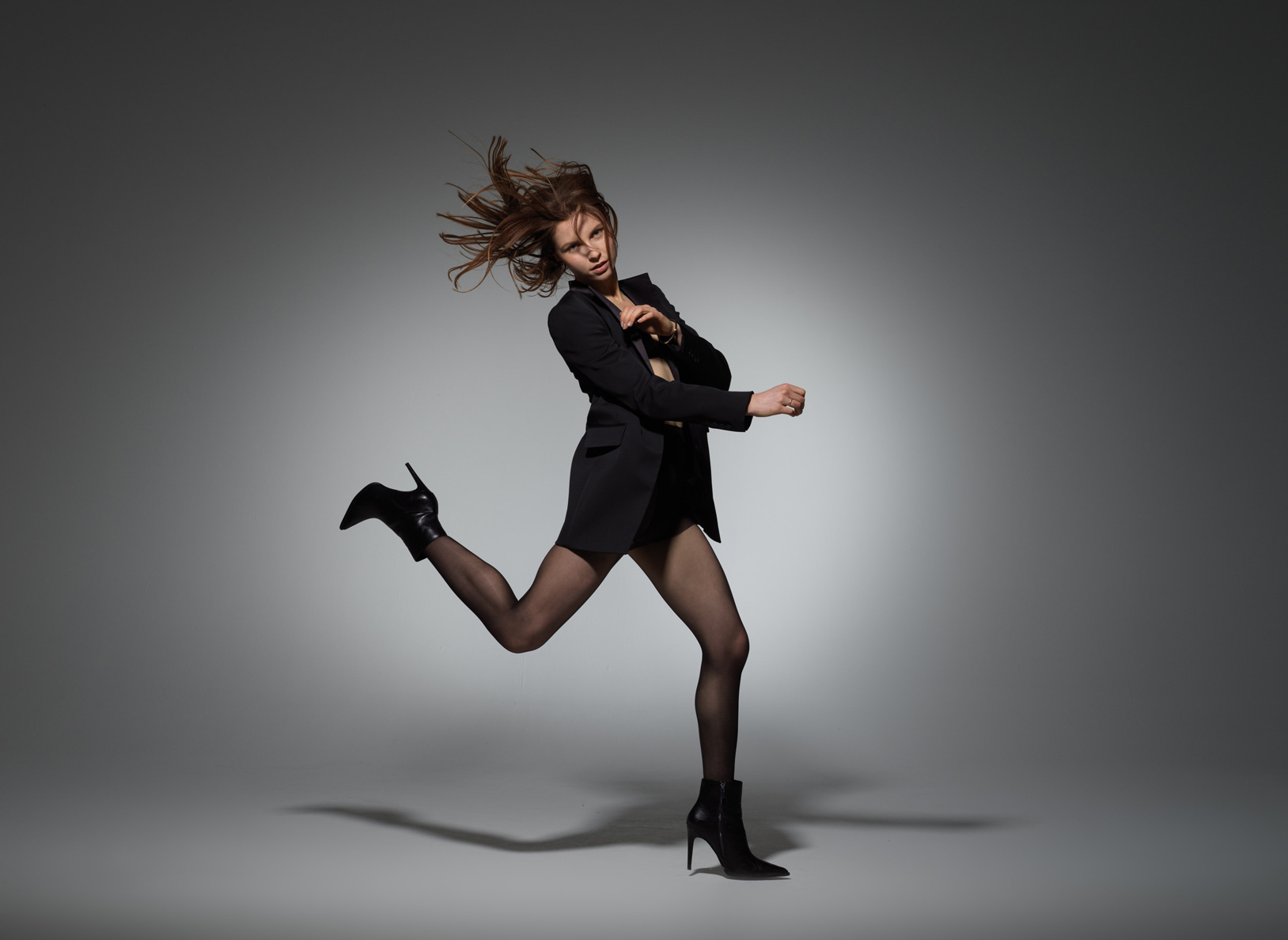Photographing a Model In Motion
Get your photography moving with this in-depth workshop.
There is a lot to consider when photographing models in motion, particularly jumping shots. To safely capture these images, you need to consider your flash speed, where to pre-focus, how high the model will be jumping, their fitness levels, movement techniques, their shoes, and how you can create a safe environment for them to work in.
In this live show, Karl explains how to photograph moving subjects, going into more detail about each of these points before demonstrating how to safely capture a jumping shot of a model. You’ll see how he uses just a single light setup, comparing results from umbrellas, softboxes and P70 reflectors, as well as how to add additional lights such as background lights and edge lighting.
Karl also covers the concept of flash duration, what duration is required for freezing these moving subjects, background choices and considerations, and what focus mode is best to use.
In this class:
- How to photograph moving subjects
- Flash duration considerations for models in motion
- Aperture choice for the correct depth of field
- Best modifiers for full-length fashion shots
- Differences between softboxes, umbrellas and reflectors
- Basic modifiers and DIY modifiers for fashion photography
- Background choice and background lighting options
Questions? Please post them in the comments section below.



Comments
is it possible to get this gradient on floor and background also in a smaller studio where are the model not so fa away from background?
I wonder if I can freeze such shots using Profoto D2 strobes?
Thank you Karl. You’re the bee’s knees!
why a gray card over a sekonic color meter for color temp? love the courses Karl!
Hi, colour meters are great but in this instance I know that the flash and the LED lights are both set at a colour temperature of 5700 Kelvin. Colour meters are more useful if you have mixed lighting temperatures.
Hi Karl,
Thank you for the live show.
You mentioned about @43:00, your flash duration was 1/2800 second which is enough to freeze the motion.
I checked my strobe duration which says 1/800 to 1/2000 (t.05) Seconds.
Do you think I am able to freeze motion like you are doing in the show if I use 2-3 together with a diffusion panel to create one big light source or is it time for me to upgrade its kit?
Please advice. Many thanks.
Hi Masa, I can only provide you facts. Your measurement is t0.5, I was using a t0.1 measurement. If we take your measurement and convert it to t0.1 Then your speeds would be about 1/500 to 1/1200 which is probably not going to be fast enough. But it all depends on how much motion and how wide angle or closed in your shot is (magnification). My advise would always be test it, test it and see. Cheers Karl.
Karl,
I just signed up for your training; finally pulled the trigger. One question about Live sessions (the next on is on “Photography Briefs”). Is there a way on your website where students can set a reminder, or sign up to have a message sent via email so they can schedule…don’t miss the sessions?
Hi John, thanks for signing up. The development guys are working on a calendar system which will be introduced on our new customer home page which also has lots of other great tools and features coming. This should be released by February. All the best Karl.
Thanks for this amazing show. I’m sorry I couldn’t make the live show but what great information. The team is fantastic – everyone seems very professional and that helped make it short and very insightful.
I love the solar cooker reflector. That would be perfect for some landscape shots I have planned. I’m looking forward to that class as I have some snowboarding and mountain bike shots planned and I think the cooker will help me get the light I need without the equipment getting in the shot. And I might be able to make a cup of tea beforehand using it 🙂
Fab show, and Brittany is a terrific model. That was a very athletic set of poses. The part I loved the most is how her face position was exactly camera forward every single time. Awesome
Looking forward to learning more, practicing more and capturing some great shots using your techniques. Happy New Year Karl and team.
Thanks Derrick, all the best to you for the new year.
Wonderful, learning a lot, Also. admire the fact you recycle reflectors to make them work to your advantage. A common reflector can be found for free from chocolate shops. they pack their goods in aluminum lined cardboard shipping boxes, then they throw them out. I use to collect them from Russel Stover chocolates when I worked in Boston, Mass in the late 70’s . It was funny when you said Fresnel was invented 200 or 300 years ago (a bit of an exaggeration humor, 1700’s?). Cinema photography I believe came about in the 1880’s. I learn so much from watching you, I am picking up quite a bit, and its getting ingrained into my head, I’m thinking more and more about what my settings are while I’m shooting so much faster, that it is less distracting and more rewarding when I see the result expected. I noticed you mouse about a bit when at your PHOCUS. Tip for you Naturalization or your Neutral Grey Tool, is the lower case keyboard (n). Maybe a Karl Taylor keyboard cap product release in the future. I also appreciated the talk on f stop versus megapixel capture with defragmenting light. For three months I shot outdoors at F4 for that Bokeh look, before I realized my lens had a sweet spot at f8.
Merry Christmas and Happy New Year, I cant wait to dig in to the Photoshop class that went along with this Models in Motion, and then dig into all the Post Production classes. I need to learn a lot. I need to get doing. It was funny hearing you say that in this class, that’s Home Depot’s slogan here in the states. How doers get more done. Very close to: lets get doing.
Thank you. Let’s all get doing! But just to clarify on the Fresnel Lens it is noted as being invented by Augustine Fresnel around 1815 and first used in a lighthouse in 1823. 1815 is 206 years ago! 🙂
great show loved all the info about the lights
a Happy xmas and wishing you and your family a lovely and healthy New Year
Also best wishes to all your team
thanks looking forward to 2021
Frank Garvan from Ireland
Thanks Frank and the team and I wish you and yours a a great Christmas and New Year.
Awesome tutorial Karl. Brittney you did a fantastic job. I will try this. I have 2 models in mind.
Thank you for a wonderful year. Merry Christmas Karl & The team…..
Thanks Karen, yes she did great and good luck giving it a go. Also the team and I wish you all the best for Christmas and the New Year.
Thank you Karl for your step by step walk through. I am enjoying your presentation of the information and I am learning a lot.
Happy Christmas to you, your crew, your family, and your crew’s family.
Cheers!
Thank you you Sean much appreciated. All the best to you.
Hi Karl!
As always, amazing professional work of your team! There is one small request, add the translation as soon as possible. Very important information becomes unavailable. Unfortunately at school I did not study English well, which I now regret. 🙂 Health and prosperity to you, your loved ones and your team in the new year!
Hi Alex, thank you. Our team are working on the subtitles as fast as we can! 🙂
Hi Karl
Who makes the 160 white umbrella? Can’t find one on the Bron website.
Kind regards
Paul
Hi Paul I purchased that one from ‘Essential Photo’ in the UK.
Great show to end this year.
Merry Christmas to Karl & Crew!
Now, if I can just locate a model that does not run “away” from me!
Ah yes John that’s been a problem for me too 🙂
Today’s live show was excellent (they are all very good), there were so many elements:
– softbox / umbrella / p70 reflector comparison
– understanding flash duration (& distinction from flash sync)
– inverse square law & modifier impact on background
– lighting & focus set up
– pre-planning & capturing the decisive moment & in focus
– various options for lighting the background
– fresnel / grid comparison
– run & jump / step & jump / on the spot jump
– model safety & comfort
AND how to use the world’s best long distance & cheapest para reflector!!
All with clear & easy to understand explanations.
Congratulations to Karl & all the team – great job. Thanks.
Thank you Andy very kind and a great summary!